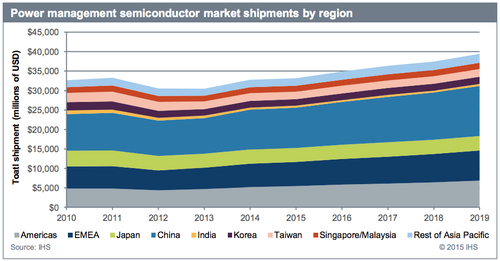Incumbent suppliers of power-management ICs have an opportunity to greatly improve efficiency and integration, or lose market to rising stars.
In
a mobile connected world, power is everything, so when we run up
against the limits of battery chemistries and space, the only options
left are to better manage system power and integrate more of those
discrete analog and power-management parts. Alas, this is easier said
than done.
For starters, the analog parts that comprise the power circuitry are
typically developed on older processes than classic vanilla CMOS so they
can handle the higher voltages and various power rails that make up a
typical system. Moving from 0.35 µm to below 90 nm raises the risk of
gate-source (MOSFET) punch-through at 5 V, and so reliability drops
quickly.This need for variability and range of power rails comes about as a result of techniques such as voltage and frequency scaling, which works in real time to deliver only the power required to operate specific ICs at the lowest possible voltage to get the job done. Try as we might, it’s nearly impossible to have all the devices on a system operate at the same lowest possible voltage. There are just too many functional variables, such as instantaneous power, slew rates, and varying device characteristics from different manufacturers, battery-charging requirements, RF transmission, solid-state drives, and the list goes on.
So, we end up with a range of voltages and processes for different circuits, and all operating at the same time over different rails with different current-delivery requirements. This has also increased the need for extra components such as diodes, inductors, capacitors, voltage regulators, to support the various voltages.
All this would be fine, except not only do we end up with more components and inventory to manage, we also suck up more board space, which we can ill afford. Still, the power management IC (PMIC) has been good for such companies as Texas Instruments, STMicroelectronics, and Infineon Technologies. Also in the mix are Renesas, NXP, Mitsubishi, Maxim Integrated, and ON Semiconductor. But TI has been the clear leader, year after year.
All together, the global market, and it truly is global now, will hit almost $40 billion by 2019, according to 2015 figures from IHS Research, up from ~$35 billion in 2016. This covers power ICs such as converters, controllers, voltage references and battery management ICs, but to name a few.

Figure
1. Power management ICs (PMICs) have a steady upward path to an almost
$40 billion by 2019, but demand for improved efficiency and integration
has created opportunities for “boutique” startups with innovative
approaches. (Image courtesy of IHS Research.)
Click here for larger image
Click here for larger image
http://www.eetimes.com/author.asp?section_id=36&doc_id=1329592
No comments:
Post a Comment